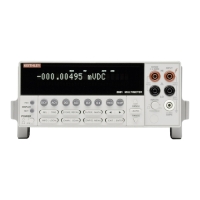IEEE-488 Reference
4-16
bit in the status register will set when the corresponding bit
in the condition register changes from 1 to 0.
The individual bits of the transition filter registers can be set
or cleared by using the following SCPI commands:
:STATus:MEASurement:PTR <NRf>
:STATus:MEASurement:NTR <NRf>
The transition filter registers can be read at any time by using
the following SCPI query commands:
:STATus:MEASurement:PTR?
:STATus:MEASurement:NTR?
Reading a transition filter register using the above query
commands does not affect the contents of the register.
The following operations will set (1) all the bits of the PTR
register and clear (0) all the bits of the NTR register:
1. Cycling power.
2. Sending the :STATus:PRESet command.
3. Sending the :STATus:MEASurement:PTR 65535 and
:STATus:MEASurement:NTR 0 commands.
Measurement Event Register This is a latched, read-
only register whose bits are set by the Measurement Condi-
tion Register and Transition Filter. Once a bit in this register
is set, it will remain set (latched) until the register is cleared
by a specific clearing operation. The bits of this register are
logically ANDed with the bits of the Measurement Event En-
able Register and applied to an OR gate. The output of the
OR gate is the Measurement Summary Bit (MSB) of the Sta-
tus Byte Register. The following SCPI query command can
be used to read the Measurement Event Register:
:STATus:MEASurement:EVENt?
Reading this register using the above SCPI command clears
the register. The following list summarizes all operations that
will clear the Measurement Event Status Register:
1. Cycling power.
2. Sending the *CLS common command.
3. Sending the :STATus:MEASurement? query command.
Measurement Event Enable Register This register is
programmed by the user and serves as a mask for the Mea-
surement Event Register. When masked, a set bit in the Mea-
surement Event Register will not set the Measurement
Summary Bit (MSB) in the Status Byte Register. Conversely,
when unmasked, a set bit in the Measurement Event Register
will set the MSB bit.
A bit in the Measurement Event Register is masked when the
corresponding bit in the Measurement Event Enable Register
is cleared (0). When the masked bit of the Measurement
Event Register sets, it is ANDed with the corresponding
cleared bit in the Measurement Event Enable Register. The
logic “0” output of the AND gate is applied to the input of
the OR gate and thus, will not set the MSB bit in the Status
Byte Register.
A bit in the Measurement Event Register is unmasked when
the corresponding bit in the Measurement Event Enable Reg-
ister is set (1). When the unmasked bit of the Measurement
Event Register sets, it is ANDed with the corresponding set
bit in the Measurement Event Enable Register. The logic “1”
output of the AND gate is applied to the input of the OR gate
and thus, will set the MSB bit in the Status Byte Register.
The individual bits of the Measurement Event Enable Regis-
ter can be set or cleared by using the following SCPI com-
mand:
:STATus:MEASurement:ENABle <NRf>
The following SCPI query command can be used to read the
Measurement Event Enable Register:
:STATus:MEASurement:ENABle?
Reading this register using the above SCPI command does
not clear the register. The following list summarizes opera-
tions that will clear the Measurement Event Enable Register:
1. Cycling power.
2. Sending the :STATus:MEASurement:ENABle 0 com-
mand.
4.6.7 Questionable event status
The reporting of questionable events is controlled by a set of
16-bit registers; the Questionable Condition Register, the
Transition Filter, the Questionable Event Register and the
Questionable Event Enable Register. Figure 4-12 shows how
these registers are structured. Each of the bits that is used in
these registers represent a questionable event. Descriptions
of the questionable event bits are provided in paragraph 4.21.
The questionable status registers are controlled by the
:STATus:QUEStionable commands in the :STATus
subsystem (see paragraph 4.21).

